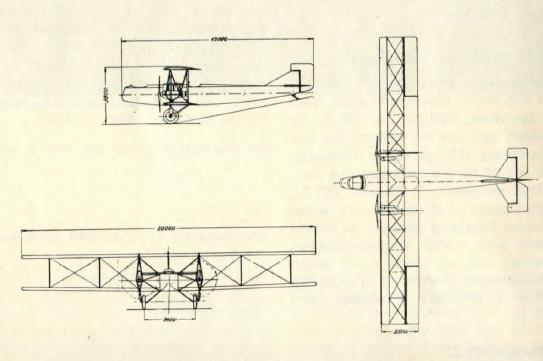| Type |
Project 1 + 1 seat, aircraft designed for advertising |
| Engine |
2 Benz Bz 4 (388 kg) or BMW IV ( 285 kg) or Junkers L5 (315 kg) |
| Dimensions |
Length 13,0 m, height 3,80 m, span 20,0 m, wing area 97,0 m2, aspect ratio 4,1 |
| Weights |
Empty 2033 kg, water 40 kg, fuel 400 kg, oil 24 kg, pilot 80 kg, payload 423 kg ( 2 Dynamos with equipment 260 kg + other 83 kg), flying weight 3000 kg, wing loading 31,0 kg/m2 |
| Performance |
Max. speed at sea level 143 km/h, cruising speed at sea level 120 km/h, climb 3,3 m/sec., service ceiling 4500 m, range 435 km, landing speed 73 km/h |

The design of the Raab-Katzenstein RK 16 was one of the largest aircraft designs by the design office of the Raab-Katzenstein works under Paul Hall. The twin-engine biplane aircraft was specially designed for night advertising flights as an advertising aircraft and had large rectangular wings, on the underside of which lighting lamps for text and images were attached. The lamps were operated from a seat in the nose of the aircraft via a control panel. A generator was connected to each of the two engines to supply power to the lamps. The RK16 was offered at a unit price of 72,000 RM, making it the most expensive Raab-Katzenstein aircraft offered in price lists. In addition to being used as an advertising aircraft, the RK16 was also offered as an aerial photography aircraft with a swiveling camera mount in the nose. There were no interested buyers for any of the applications, so the development was abandoned at the design stage.[1]
The construction of the RK16 was unique for the Raab-Katzenstein works in every respect. The fuselage is autogenously welded from seamless steel tubes. The engine mounts are removable. They form a unit with the wing center sections and the chassis. The wide-track chassis is cushioned by means of spring struts that engage the lower nodes of the engine mounts. The engine mounts are installed between the wings and connected to the fuselage by a strut framework. The 230 hp BMW IV engine in the RaKa RK16b or the 280 hp Junkers L5 engine in the RaKa RK16c were planned as the drive. For the RaKa RK16a, the use of used Benz Bz4 engines was proposed to reduce costs.
Source Aerokurier 1970
RK 16 - special aircraft for illuminated advertising
The RK 16 was Raab-Katzenstein's first twin-engine project. The idea was to build a simple, lightweight aircraft with large wings to make it particularly suitable for illuminated advertising purposes. Large wings lead to a low wing load with generally good flight characteristics. The aircraft was a two-spar biplane. The upper and lower wings were attached to the engine mount. The wings were made of wood with fabric covering in a two-spar design. The fuselage was autogenously welded from seamless steel tubes. The axleless undercarriage with a wide track consisted of two parts. Suspension was provided by spring struts that were attached to the lower nodes of the engine blocks. The aircraft had two seats, one at the front of the fuselage, reminiscent of an observer or bombardier's position, and a seat under the last third of the upper wing for the pilot. It is unclear whether the project was only intended for photo purposes or was also offered for possible military use. Raab and Katzenstein claim to know nothing more about the aircraft project. However, an original drawing from December 3, 1927 with the signature of chief designer Hall and his calculations is available.
Three different engines were planned for propulsion, either the Benz Bz-4 with 220 hp or the BMW IV with 230 hp or the Junkers L 5 with 280 hp. The engines were arranged on the sides of the fuselage between the wings. The engine mounting brackets were connected to the fuselage by a strut framework. There were two drop fuel tanks in the upper wing center section, and the main boom in the fuselage center section. Behind the engines, a generator was planned on each of the engine brackets. These generators were to be driven directly by the engines. A control panel for illuminated advertising purposes was planned in the front seat.
The simple and standard tail unit consisted of a steel tube frame and was covered with canvas. A handwheel was used to operate the ailerons, and pedals were provided for operating the rudder. The aircraft would not have been able to maintain altitude with one engine. However, with the Benz Bz-4 engines it would have had a glide angle of 1:27 at full throttle and one engine off, 1:30 with a BMW IV engine and 1:62 with the Junkers L 5 engine. The twin-engine aircraft was offered at the time for a price of 48,000 RM with Benz engines, 72,000 RM with Junkers L 5 engines and 70,000 RM with BMW V engines. However, it remained only a design and the RK 16 was never built.
